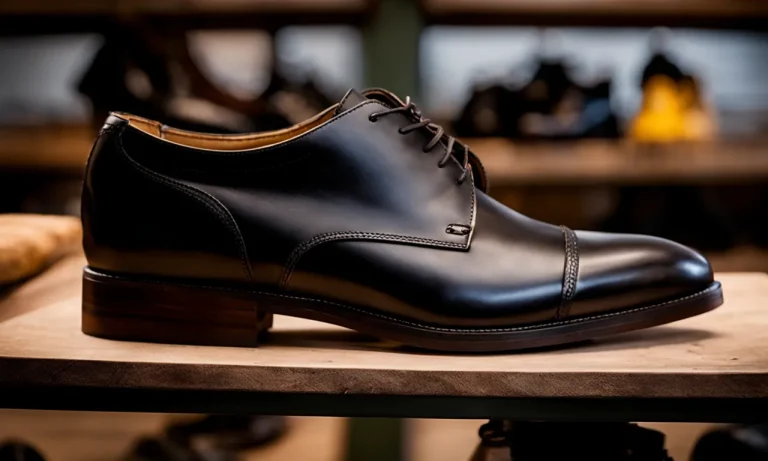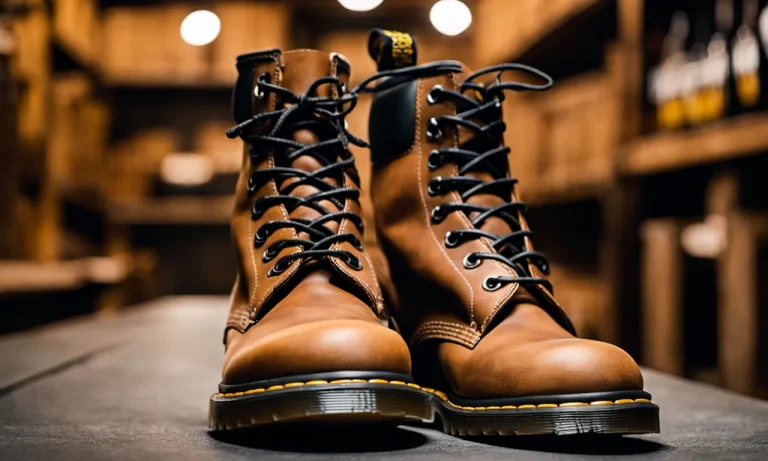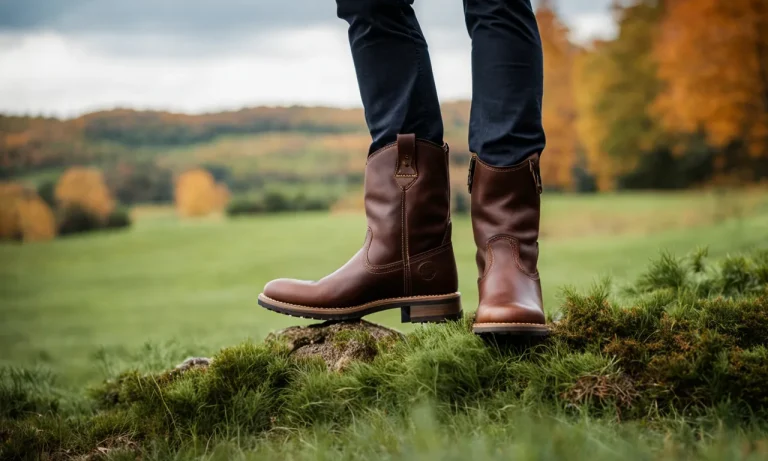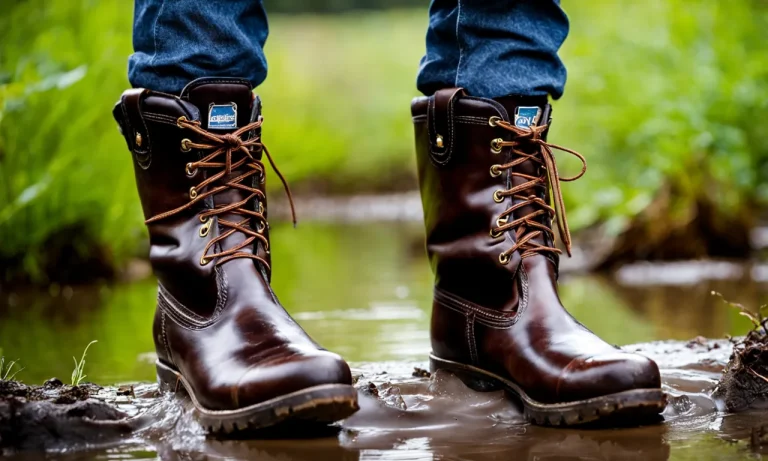If you own a pair of leather boots, you know how important it is to keep the leather conditioned and protected. Using mink oil is one of the best ways to do this. Mink oil penetrates deep into the leather, conditioning it from the inside out and providing long-lasting moisture that keeps the leather supple and flexible.
In this comprehensive guide, we’ll teach you everything you need to know about using mink oil on boots.
If you’re short on time, here’s a quick answer to your question: Apply a thin layer of mink oil to clean, dry leather boots using a clean, lint-free cloth. Rub the oil in with gentle, circular motions. Allow the boots to absorb the oil completely before wearing, usually 24-48 hours.
Reapply every 2-3 months for continued conditioning and water resistance.
Choosing the Right Mink Oil
When it comes to using mink oil on your boots, it’s important to choose the right product. Here are some factors to consider when selecting mink oil:
Look for 100% natural mink oil
It is crucial to ensure that the mink oil you choose is made from 100% natural ingredients. Synthetic or diluted oils may not provide the same level of protection and nourishment to your boots. Look for products that clearly state they are made from pure mink oil.
Consider additives like vitamin E or UV blockers
Some mink oil products come with additional additives such as vitamin E or UV blockers. Vitamin E can help moisturize and condition the leather, while UV blockers can protect your boots from harmful sun rays.
These additives can enhance the effectiveness of the mink oil and provide extra benefits for your boots.
Pick an oil consistency based on your climate
The consistency of the mink oil can vary, and it’s important to choose one that suits your climate. In colder climates, a thicker oil may be more suitable as it can provide better protection against moisture and harsh weather conditions.
In warmer climates, a lighter oil may be preferable as it allows the leather to breathe more easily.
Remember to read product labels and descriptions carefully to ensure that the mink oil you choose aligns with your specific needs. Consulting with a professional cobbler or experienced boot enthusiast can also provide valuable insights and recommendations.
Prepping Your Boots for Mink Oil
Clean the boots
Before applying mink oil to your boots, it’s important to start with a clean surface. Use a soft brush or cloth to remove any dirt or debris from the boots. This will ensure that the mink oil can penetrate the leather effectively and provide maximum protection.
Allow boots to dry completely
After cleaning the boots, it’s crucial to allow them to dry completely before applying mink oil. This is because applying the oil to damp or wet leather can result in uneven absorption and a less effective treatment. Leave the boots in a well-ventilated area and allow them to air dry naturally.
Avoid using direct heat sources, such as heaters or hair dryers, as they can damage the leather.
Remove laces and inserts
Prior to applying mink oil, it’s recommended to remove the laces and any removable inserts from your boots. This will allow you to access all areas of the leather and ensure that the mink oil is evenly distributed.
It’s also a good opportunity to clean the laces separately and inspect the inserts for any signs of wear or damage.
Once you have completed these steps, you can proceed with applying the mink oil to your boots. Remember to follow the manufacturer’s instructions for the specific oil you’re using and use a clean, soft cloth or brush to apply the oil in a thin, even layer.
Allow the oil to penetrate the leather for a few hours or overnight before wiping off any excess with a clean cloth. Your boots will be ready to go and well-protected against moisture and other elements!
How to Apply Mink Oil
Work in a well-ventilated area
Before applying mink oil to your boots, it is important to work in a well-ventilated area. Mink oil has a strong odor that may be unpleasant for some people. Additionally, the fumes from the oil can be harmful if inhaled in large quantities.
Opening windows or working outdoors can help dissipate the smell and keep you safe while applying the oil.
Shake the mink oil bottle before using
Prior to applying mink oil to your boots, it is recommended to shake the bottle well. This helps to ensure that the oil is thoroughly mixed and ready for use. Shaking the bottle also helps to break up any clumps or separation that may have occurred during storage.
By doing this, you can ensure that you are applying a consistent and effective layer of oil to your boots.
Apply a thin layer of oil
When applying mink oil to your boots, it is important to use a thin layer. Applying too much oil can lead to the boots becoming greasy and may affect their appearance. Using a small amount of oil and spreading it evenly across the surface of the boots will help to ensure that the oil is absorbed properly.
Rub in the oil thoroughly
After applying the mink oil to your boots, it is important to rub it in thoroughly. Using a clean cloth or sponge, gently massage the oil into the leather, paying attention to any areas that may be particularly dry or worn.
This helps to ensure that the oil is evenly distributed and absorbed by the leather.
Pay special attention to seams and edges
When applying mink oil to your boots, it is important to pay special attention to the seams and edges. These areas are often more prone to drying out and can benefit from additional oil. Using your fingers or a brush, make sure to work the oil into these areas to provide extra protection and moisture.
Allow the boots to absorb the oil fully before wearing
After applying mink oil to your boots, it is important to allow them to fully absorb the oil before wearing them. This typically takes several hours or even overnight. By giving the boots enough time to absorb the oil, you can ensure that they receive the maximum benefits and protection from the mink oil.
Remember, mink oil is a great way to condition and protect your boots, but it is important to follow these steps for proper application. By working in a well-ventilated area, shaking the oil bottle, applying a thin layer, rubbing it in thoroughly, paying special attention to seams and edges, and allowing the boots to fully absorb the oil, you can keep your boots looking great and performing well for years to come.
Caring for Mink-Oiled Boots
Mink oil is a popular choice for conditioning and protecting leather boots. It helps to soften the leather, prevent cracking, and repel water. To ensure that your mink-oiled boots last for years, it’s important to follow a few care tips.
Here’s a complete guide on how to care for your mink-oiled boots:
Let boots dry between wears
After wearing your boots, make sure to let them dry completely before wearing them again. This is especially important if your boots have gotten wet. Wet leather can become damaged if not allowed to dry properly.
Place your boots in a well-ventilated area and avoid using direct heat sources like heaters or hair dryers, as they can cause the leather to become brittle.
Use cedar shoe trees to maintain shape
To maintain the shape of your mink-oiled boots, consider using cedar shoe trees when they’re not being worn. Cedar shoe trees help to absorb moisture and odors, while also preventing the leather from developing creases and wrinkles.
Additionally, they help to maintain the overall shape and structure of the boots, ensuring a comfortable fit every time you wear them.
Reapply mink oil every 2-3 months
To keep your boots well-conditioned and protected, it’s recommended to reapply mink oil every 2-3 months. Apply a small amount of mink oil to a clean cloth or sponge and gently rub it onto the leather in a circular motion.
Be sure to cover the entire surface of the boots, paying extra attention to any areas that may be prone to dryness or cracking. Allow the boots to absorb the oil overnight before wearing them again.
Use leather conditioner for light conditioning between oiling
In addition to regular mink oil applications, it’s a good idea to use a leather conditioner for light conditioning between oiling. Leather conditioners help to moisturize and protect the leather, keeping it soft and supple.
Apply the conditioner according to the manufacturer’s instructions, using a clean cloth or sponge. This will help to maintain the overall health and appearance of your mink-oiled boots.
Remove salt stains quickly
If your boots come into contact with salt or road salt during the winter months, it’s important to remove the stains as quickly as possible. Salt stains can cause discoloration and damage to the leather if left untreated.
To remove salt stains, mix equal parts water and white vinegar and gently dab the solution onto the affected areas using a clean cloth. Allow the boots to air dry, and then reapply mink oil to restore moisture and protect the leather.
By following these care tips, you can ensure that your mink-oiled boots stay in great condition for years to come. Remember, proper maintenance and regular care are key to prolonging the life of your boots and keeping them looking their best.
Frequently Asked Questions
Can I use mink oil on suede or nubuck?
It is generally not recommended to use mink oil on suede or nubuck. Mink oil is a heavy and oily substance that can darken and stain these delicate materials. Instead, opt for a specialized suede or nubuck protector or cleaner.
These products are specifically designed to clean and protect these types of leather, without causing any damage or discoloration.
What kind of cloth should I use to apply mink oil?
When applying mink oil to your boots, it is best to use a soft, lint-free cloth. This will ensure that you don’t leave any unwanted fibers or residue on the leather. Microfiber cloths or old cotton t-shirts work well for this purpose.
Avoid using paper towels or abrasive materials, as they can scratch the leather surface.
How long does it take for mink oil to dry?
The drying time for mink oil can vary depending on factors such as the temperature and humidity levels in your environment. Generally, it takes about 24 hours for mink oil to fully dry and absorb into the leather.
During this time, it is recommended to keep your boots in a well-ventilated area and avoid wearing them to allow the oil to penetrate and nourish the leather effectively.
Will mink oil darken leather?
Yes, mink oil has the potential to darken leather, especially lighter-colored or unfinished leathers. It is always a good idea to test a small, inconspicuous area of your boots before applying mink oil to the entire surface.
If you are concerned about darkening the leather, consider using a leather conditioner or protector specifically designed to maintain the color and finish of your boots.
Is mink oil waterproof?
Mink oil is known for its water-repellent properties, making it an excellent choice for protecting your boots from moisture. However, it is important to note that mink oil is not completely waterproof.
While it can provide a certain level of protection against water, it is still advisable to avoid prolonged exposure to excessive moisture or submerging your boots in water. Regular reapplication of mink oil can help maintain its water-resistant qualities.
Conclusion
Mink oil is a time-tested leather conditioner that nourishes and protects leather boots. With proper prep, application, and care, mink oil will keep your boots supple and resilient for many seasons of wear.
Just remember to clean boots first, apply oil sparingly, let them dry fully, and reapply every 2-3 months. With a little TLC and mink oil, your boots will last for years to come!






